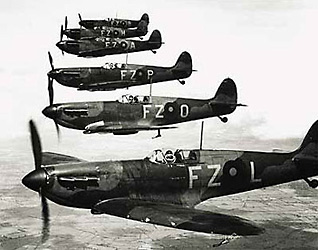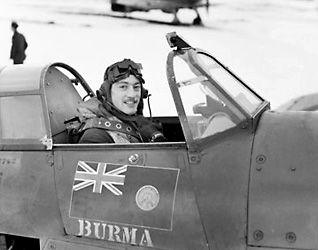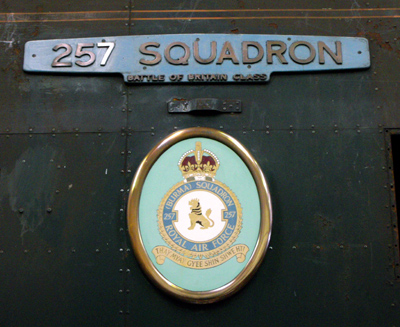A Short History of RAF 257 Squadron
WWI
257 Squadron was formed at Dundee on 18 August 1918 from Nos. 318 and 319 Flights. It flew both seaplanes and flying boats on anti-submarine patrols from Dundee until the end of the First World War and disbanded there on 30 June 1919
WWII - Battle of Britain
The squadron was re-formed on 17 May 1940, a few weeks before the Battle of Britain at RAF Hendon as a Fighter Squadron, equipped with Spitfires. The squadron became operational at RAF Northolt, where the squadron flew Hurricanes in the Battle of Britain, during which it was part of 11 Group RAF, led by Sir Keith Park. The squadron was based in south-east England throughout the Battle of Britain and in March 1941 began taking part in sweeps over France. Night fighter patrols were also flown and in July 1942 converted to Typhoons which began low-level patrols in September to intercept enemy fighter-bomber raids.
 |
 |
|
A wing of Spitfires during the Battle of Britain. |
Robert Stanford Tuck, Squadron Leader of 257 Squadron in a Hurricane. |
Escort missions were also flown and in July 1943 it began offensive operations. The squadron started fighter-bombing sorties in January 1944, and as part of Second Tactical Air Force moved to France in July to provide air support for the Allied armies. By October 1944 it was based in Belgium for attacks on enemy transport and battlefield targets. The Squadron disbanded on 5 March 1945. During the Second World War the squadron was the Burma gift squadron; the chinte in its logo is a Burmese effigy and this appears in the loco's crest.
 |
The squadron's motto was "Thay Myay Gyee Shin Shwe Hti" which is the Burmese for Death or Glory. The symbol on the crest is a Burmese "Chinti" representing martial arts. In WWII the squadron was the "Burma Gift" meaning that it was paid for by the people of Burma. |
After WWII
On 1 September 1946 the squadron was re-formed at RAF Church Fenton as a fighter squadron flying Gloster Meteors until January 1955. It then converted to Hawker Hunters. On 31 March 1957 the squadron was disbanded for the third time. The squadron re-emerged on 1 July 1960 at RAF Warboys as an air defence unit using Bristol Bloodhound missiles till 31 December 1963, when the squadron was disbanded for the fourth time.
Robert Stanford Tuck
257 Squadron's best known pilot was Squadron Leader Robert Stanford Tuck who took command in September 1940 and led it for the rest of the Battle of Britain. This YouTube clip includes wartime newsreel and an interview with Tuck talking about his exploits. Like many of his peers Tuck's post-war life was a world away from aerial combat - he ran a mushroom farm in Kent.
